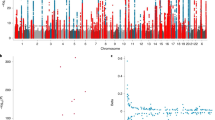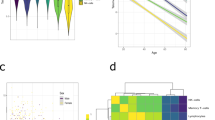Abstract
We conducted genome-wide association analyses of mean leukocyte telomere length in 2,917 individuals, with follow-up replication in 9,492 individuals. We identified an association with telomere length on 3q26 (rs12696304, combined P = 3.72 × 10−14) at a locus that includes TERC, which encodes the telomerase RNA component. Each copy of the minor allele of rs12696304 was associated with an ∼75-base-pair reduction in mean telomere length, equivalent to ∼3.6 years of age-related telomere-length attrition.
This is a preview of subscription content, access via your institution
Access options
Subscribe to this journal
Receive 12 print issues and online access
$209.00 per year
only $17.42 per issue
Buy this article
- Purchase on Springer Link
- Instant access to full article PDF
Prices may be subject to local taxes which are calculated during checkout

Similar content being viewed by others
Change history
16 April 2010
Dr. Abraham Aviv and Dr. Masayuki Kimura were inadvertently omitted from the author list and the author contribution statement in the version of the manuscript initially published on February 7, 2010. This has been corrected in the online html and PDF.
References
Blackburn, E.H., Greider, C.W. & Szostak, J.W. Nat. Med. 12, 1133–1138 (2006).
Njajou, O.T. Proc. Natl. Acad. Sci. USA 104, 12135–12139 (2007).
Vasa-Nicotera, M. et al. Am. J. Hum. Genet. 76, 147–151 (2005).
Andrew, T. et al. Am. J. Hum. Genet. 78, 480–486 (2006).
Mangino, M. et al. Hum. Mol. Genet. 17, 2518–2523 (2008).
Mangino, M. et al. J. Med. Genet. 46, 451–454 (2009).
Samani, N.J. et al. Am. J. Hum. Genet. 77, 1011–1020 (2005).
Wellcome Trust Case Control Consortium. Nature 447, 661–678 (2007).
Cawthon, R.M. Nucleic Acids Res. 30, e47 (2002).
Tobin, M.D. et al. Hypertension 51, 1658–1664 (2008).
Spector, T.D. & Williams, F.M. Twin Res. Hum. Genet. 9, 899–906 (2006).
Hillege, H.L. et al. Circulation 106, 1777–1782 (2002).
Hara, Y. et al. FEBS Lett. 582, 2998–3004 (2008).
Kobe, B. & Kajava, A.V. Curr. Opin. Struct. Biol. 11, 725–732 (2001).
Rabenau, K.E. et al. Oncogene 23, 5056–5067 (2004).
Acknowledgements
The BHF-FHS Study and the GRAPHIC Study were supported by the BHF. The WTCCC and recruitment of the UKBS donors were funded by the Wellcome Trust. The TwinsUK study was funded by the Wellcome Trust and Biotechnology and Biological Sciences Research Council project grant G20234. The PREVEND study is supported by the Dutch Kidney Foundation (grant E033), The Netherlands Heart Foundation (grant 2006B140, 2006T003) and the EU project grant Genomic Strategies for Treatment and Prevention of Cardiovascular Death in Uraemia and End-stage Renal Disease (GENECURE) (FP-6 LSHM CT 2006 037697). We thank J. Marchini for generating the imputed genotypes for the WTCCC cohorts and J. Gardner for generating the telomere length data in the TwinsUK study. V.C., A.H.G. and N.J.S. are supported by the BHF and the Leicester National Institute of Health Research (NIHR) Biomedical Research Unit in Cardiovascular Disease. M.M. and T.D.S. are supported by NIHR Biomedical Research Centre award to Guy's & St Thomas' National Health Service Foundation Trust in partnership with King's College London. P.vd.H. is supported by the Netherlands Organisation for Scientific Research (NWO) VENI grant 916.76.170 and the Interuniversity Cardiology Institute of the Netherlands (ICIN). Collaboration between the WTCCC Study telomere GWAS and the TwinsUK study was established under the European Framework 7 (FP7/2007-2013) European Network for Genetic and Genomic Epidemiology (ENGAGE) project (HEALTH-F4-2007- 201413).
Author information
Authors and Affiliations
Consortia
Contributions
N.J.S. and T.S. conceived the study. V.C., M.M. and P.v.d.H. designed the laboratory work and conducted the analyses. V.C., P.S.B., M.Kaiser, J.M., I.M.L. and R.A.d.B. undertook the laboratory work. A.J.B. provided bioinformatics support and S.R., C.N. and N.S. undertook statistical support. A.S.H. and N.J.S. recruited and provided samples and data from the BHF Family Heart Study; W.T.C.C.C. and W.O. from the UKBS samples; A.H.G., P.R.B., M.D.T. and N.J.S. from the GRAPHIC study; G.Z., A.M.V., H.B., M.Kimura, A.A. and T.S. from the TwinsUK study; and D.J.v.V., W.H.v.G. and G.N. from the PREVEND Study. J.R.T. oversaw the statistical analysis. The paper was written by V.C., M.M. and N.J.S. All authors contributed to the final version of the manuscript.
Corresponding author
Ethics declarations
Competing interests
The authors declare no competing financial interests.
Additional information
A full list of members is provided is provided in the Supplementary Note.
Supplementary information
Supplementary Text and Figures
Supplementary Figure 1, Supplementary Tables 1–5, Supplementary Methods and Supplementary Note (PDF 963 kb)
Rights and permissions
About this article
Cite this article
Codd, V., Mangino, M., van der Harst, P. et al. Common variants near TERC are associated with mean telomere length. Nat Genet 42, 197–199 (2010). https://doi.org/10.1038/ng.532
Received:
Accepted:
Published:
Issue Date:
DOI: https://doi.org/10.1038/ng.532
This article is cited by
-
Telomere length and cancer risk: finding Goldilocks
Biogerontology (2024)
-
Biological basis of extensive pleiotropy between blood traits and cancer risk
Genome Medicine (2024)
-
Association between leukocyte telomere length and COVID-19 severity
Egyptian Journal of Medical Human Genetics (2023)
-
Ethnicity-specific association between TERT rs2736100 (A > C) polymorphism and lung cancer risk: a comprehensive meta-analysis
Scientific Reports (2023)
-
Leukocyte telomere length, allelic variations in related genes and risk of coronary heart disease in people with long-standing type 1 diabetes
Cardiovascular Diabetology (2022)



